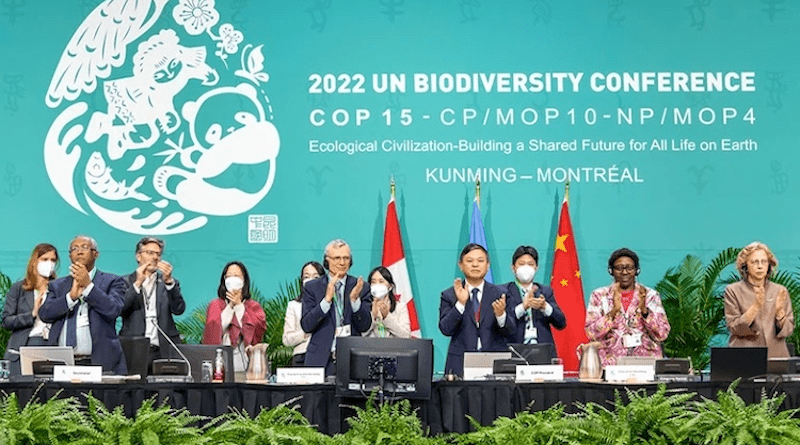Landmark UN Biodiversity Agreement Achieved – OpEd
By IDN
By J C Suresh
Countries around the world have agreed on a historic package of measures aimed at addressing the dangerous loss of biodiversity and restoring natural ecosystems. The agreement was achieved after a two-week-long 15th Conference of Parties (COP15) to the UN Convention on Biological Diversity on December 19.
Convened under UN auspices, chaired by China, and hosted by Canada in Montreal, COP15 adopted the “Kunming-Montreal Global Biodiversity Framework” (GBF), including four goals and 23 targets for achievement by 2030.
The targets include:
Effective conservation and management of at least 30% of the world’s lands, inland waters, coastal areas and oceans, with emphasis on areas of particular importance for biodiversity and ecosystem functioning and services. The GBF prioritizes ecologically-representative, well-connected and equitably-governed systems of protected areas and other effective area-based conservation, recognizing indigenous and traditional territories and practices. Currently, 17% and 10% of the world’s terrestrial and marine areas respectively are under protection.
Have restoration completed or underway on at least 30% of degraded terrestrial, inland waters, and coastal and marine ecosystems
Reduce to near zero the loss of areas of high biodiversity importance, including ecosystems of high ecological integrity
Cut global food waste in half and significantly reduce overconsumption and waste generation.
Reduce by half both excess nutrients and the overall risk posed by pesticides and highly hazardous chemicals.
Progressively phase out or reform by 2030 subsidies that harm biodiversity by at least $500 billion per year while scaling up positive incentives for biodiversity’s conservation and sustainable use.
Mobilize by 2030 at least $200 billion per year in domestic and international biodiversity-related funding from all sources – public and private.
Raise international financial flows from developed to developing countries, in particular least developed countries, small island developing States, and countries with economies in transition, to at least US$ 20 billion per year by 2025, and to at least US$ 30 billion per year by 2030.
Prevent the introduction of priority invasive alien species, and reduce by at least half the introduction and establishment of other known or potentially invasive alien species, and eradicate or control invasive alien species on islands and other priority sites.
Require large and transnational companies and financial institutions to monitor, assess, and transparently disclose their risks, dependencies and impacts on biodiversity through their operations, supply and value chains and portfolios.
The GBF warns: “Without such action, there will be a further acceleration in the global rate of species extinction, which is already at least tens to hundreds of times higher than it has averaged over the past 10 million years.”
The framework’s four predominant global goals are:
GOAL A
The integrity, connectivity and resilience of all ecosystems are maintained, enhanced, or restored, substantially increasing the area of natural ecosystems by 2050;
Human-induced extinction of known threatened species is halted, and by 2050, the extinction rate and risk of all species are reduced tenfold, and the abundance of native wild species is increased to healthy and resilient levels;
The genetic diversity within populations of wild and domesticated species is maintained, safeguarding their adaptive potential.
GOAL B
Biodiversity is sustainably used and managed and nature’s contributions to people, including ecosystem functions and services, are valued, maintained and enhanced, with those currently in decline being restored, supporting the achievement of sustainable development for the benefit of present and future generations by 2050
GOAL C
The monetary and non-monetary benefits from the utilization of genetic resources, and digital sequence information on genetic resources, and of traditional knowledge associated with genetic resources, as applicable, are shared fairly and equitably, including, as appropriate, with indigenous peoples and local communities, and substantially increased by 2050, while ensuring traditional knowledge associated with genetic resources is appropriately protected, thereby contributing to the conservation and sustainable use of biodiversity, in accordance with internationally agreed access and benefit-sharing instruments.
GOAL D
Adequate means of implementation, including financial resources, capacity-building, technical and scientific cooperation, and access to and transfer of technology to fully implement the Kunmin-Montreal global biodiversity framework, are secured and equitably accessible to all Parties, especially developing countries, in particular the least developed countries and small island developing States, as well as countries with economies in transition, progressively closing the biodiversity finance gap of $700 billion per year, and aligning financial flows with the Kunmin-Montreal Global Biodiversity Framework and the 2050 Vision for Biodiversity.
In addition to the GBF, the meeting approved a series of related agreements on its implementation, including planning, monitoring, reporting and review; resource mobilization; helping nations to build their capacity to meet the obligations; and digital sequence information on genetic resources.
Digital sequence information on genetic resources—a dominant topic at COP15—has many commercial and non-commercial applications, including pharmaceutical product development, improved crop breeding, taxonomy, and the monitoring of invasive species.
COP15 delegates agreed to establish within the GBF a multilateral fund for the equitable sharing of benefits between providers and users of DSI, to be finalized at COP16 in Turkey in 2024.
The agreement also obligates countries to monitor and report every five years or less on a large set of “headline” and other indicators related to progress against the GBF’s goals and targets.
Headline indicators include the percentage of land and seas effectively conserved, the number of companies disclosing their impacts and dependencies on biodiversity, and many others.
The CBD will combine national information submitted by late February 2026 and late June 2029 into global trends and progress reports.

